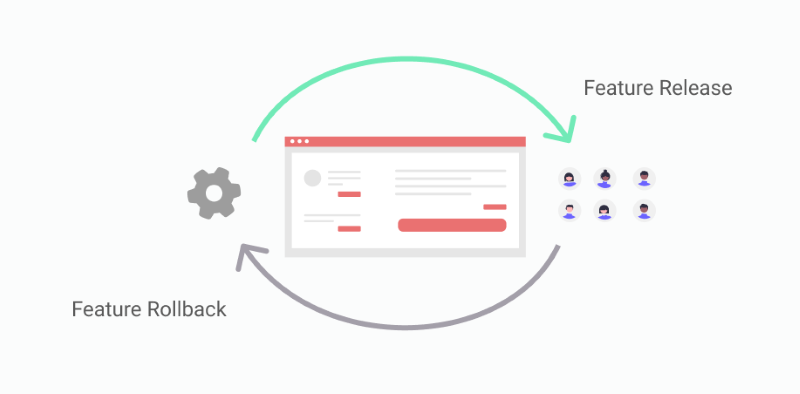Python Feature Flag
(Everything You Need To Know)

Python feature flags can provide you with the following benefits:
Separate Python code deployments from feature releases.
Utilize feature flags to release certain features to targeted user segments.
Use remote switches to manage the lifecycle of individual features.
Test new features without fear of having to roll back the entire application.
If you are developing Python applications, you will recognize the importance of having access to tools that enable you to deploy faster and release with confidence. When Python developers are working at speed, it's often easy for things to break. To continue working at speed and deliver successful rollouts, you need tools that enable you to instantly roll back bug-ridden features.
With access to a feature flagging solution, Python developers can control behavior within an application - by enabling and disabling different features - without having to deploy a different version. This is a game-changer for Python developers that want to avoid downtime and offer exceptional user experiences. Decoupled deployments also create a safety net for developers.
You can take big swings with your Python code and experiment with new features while ensuring your Python application is kept in a releasable state for users. In this guide, we will cover everything you need to know about Python feature flags and how your developer team can leverage these to enhance their workflows and improve deployment speed.
Python Feature Flags (What Are They?)
You can think of Python feature flags as a way to control the behavior of user segments in your application. For instance, if you only want a specific subset of users to have access to a feature, you can isolate this feature and enable access for those users - without deploying a different version of your application. This is often useful for Python applications with premium users.
Feature flagging tools allow Python developers to manage feature rollouts and isolate these away from the main application. If you are split-testing different functionalities and need to ensure this is completed safely, you can utilize feature flags to release certain features to targeted user segments. Importantly, you can even limit access to features after rollouts.
Python Feature Flags (What Are They?)
You can think of Python feature flags as a way to control the behavior of user segments in your application. For instance, if you only want a specific subset of users to have access to a feature, you can isolate this feature and enable access for those users - without deploying a different version of your application. This is often useful for Python applications with premium users.
Feature flagging tools allow Python developers to manage feature rollouts and isolate these away from the main application. If you are split-testing different functionalities and need to ensure this is completed safely, you can utilize feature flags to release certain features to targeted user segments. Importantly, you can even limit access to features after rollouts.
To summarize, Python feature flags enable you to:
Control the behavior of user segments in your application.
Provide specific subsets of users with access to certain features.
Split-test different functionalities across your userbase.
Python Feature Flag Development (Why Does It Matter?)
Low-risk deployments
With the ability to separate Python code deployments from feature releases, your developers can have the confidence to ship code faster. Feature flagging provides development teams with a safety net for testing new functionalities before officially adding these to the live application. You can progressively release features to target user segments at a pace that suits your team.
Feature flagging tools are essential to testing isolated features in your Python application before they are rolled out to all users. Flag management allows you to deploy code that is kept away from your application's main rollout. If something goes wrong with the code related to a specific feature, you can simply disable the feature without needing to deploy a new version of the app.
Manage the lifecycle of features
As you progress through different stages of feature development, you can use remote switches to manage the lifecycle of individual features in your Python application. You can do this without rolling out the feature in the standard user experience. By keeping the feature separate from the rest of your live code, you can manage its progression through multiple development stages.
When Python developers have the ability to alter user experiences for certain segments by simply changing a feature toggle, this creates an important sense of freedom. Developers can make changes to features and push them further without fear of having to roll back the entire application. Instead, they can roll back individual features without affecting the live code.
Experiment without disruption
Naturally, as your Python applications evolve over time, you will want to explore the possibilities of new features. No matter where you are in the development of your Python application, you can leverage feature flags to deploy code in a live (and entirely controlled) environment. The potential use cases for feature flags extend far beyond the pre-release testing stage.
When you have the freedom to experiment with a Python application's functionality without fear of causing downtime or impacting users, this can help to fuel innovation. If you are working hard to make changes to a particular feature and this feature ends up breaking, you could use a feature flag to isolate the feature and take it offline until the issues are successfully resolved.

How Are Python Developers Using Feature Flag Deployment?
There is no shortage of scenarios in which Python developers can use feature flag deployment to accelerate their workflows. The only limit is your imagination. To get your creative juices flowing, let's consider a few practical use cases for feature flag deployment.
Create the perfect environment for split testing functionalities
Feature flags allow Python developers to decouple deployments from releases - which creates the ideal environment for split testing functionalities with different user segments. You can run these tests to see which features bring value to certain user segments. These tests can inform your team's work going forward and help to focus your efforts on developing the right features.
Mitigate the risk of coding bugs with instant rollbacks
You can think of feature flags as kill switches. They enable you to switch off bug-ridden code with a single toggle. You do not need to worry about quickly calling upon engineering resources to address emergencies and come up with rapid fixes. With remotely-controlled feature flags, you can temporarily isolate and disable problematic features with a simple toggle switch.
Give sales teams tools to offer tailored user experiences
Feature flagging tools can play an instrumental role in enabling sales and marketing teams to offer tailored user experiences. If your target user base is not looking for a one-size-fits-all solution, feature flagging will allow you to unlock different experiences with certain user segments and deliver a truly custom solution that meets their unique requirements.
Why use a feature flag as a service solution?
Instead of attempting to build a feature flag infrastructure in-house, it makes sense to leverage a feature flag service like ConfigCat. This platform can do all the heavy lifting for you. When it comes to flag management, having a solution like ConfigCat in your corner is critical to success. The centralized approach enables you to enable and disable feature flags at the tap of a button.
How can you maintain multiple Python feature flags?
Once a feature flag is no longer needed, it’s best to simply remove it from the codebase. There is nothing worse than trying to manage a convoluted codebase. Developers should always aim to keep their codebase clean and maintainable. When issues arise, it’s important to have the ability to quickly navigate through the codebase to resolve problems quickly.
Python Feature Flag Testing (Best Solution For 2023)
When picking a Python feature flag management platform, you should look for the following:
A developer-centric solution
The ability to target user segments
Open source SDKs for easy integration
Sure, we’re a little biased but ConfigCat ticks all of these boxes and plenty more.
If you are searching high and low for the best Python feature flag tool, look no further than ConfigCat. When it comes to the creation and deployment of Python feature flags, this is a must-have tool. ConfigCat supports simple feature toggles, user segmentation, and A/B testing and has a generous free tier for low-volume use cases or those just starting out.
Created by developers for developers with ❤️.
